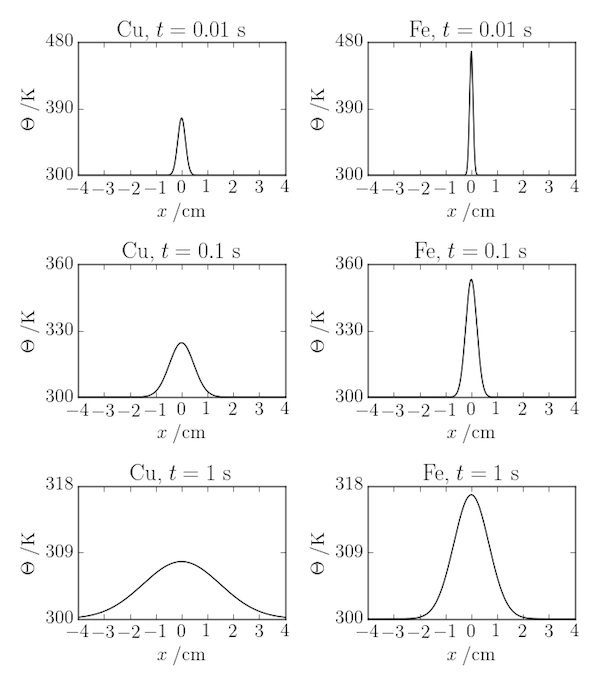Consider a metal bar of cross-sectional area, $A$, initially at a uniform temperature, $\theta_0$, which is heated instantaneously at the exact centre by the addition of an amount of energy, $H$. The subsequent temperature of the bar (relative to $\theta_0$) as a function of time, $t$, and position, $x$ is governed by the one-dimensional diffusion equation: $$ \theta(x,t) = \frac{H}{c_pA}\frac{1}{\sqrt{Dt}}\frac{1}{\sqrt{4\pi}}\exp\left(-\frac{x^2}{4Dt}\right), $$ where $c_p$ and $D$ are the metal's specific heat capacity per unit volume and thermal diffusivity (which we assume are constant with temperature). The following code plots $\theta(x, t)$ for three specific times and compares the plots between two metals, with different thermal diffusivities but similar heat capacities, Copper and Iron.
# eg7-diffusion1d.py
import numpy as np
import matplotlib.pyplot as plt
# Cross sectional area of bar in m3, heat added at x=0 in J
A, H = 1.e-4, 1.e3
# Temperature in K at t=0
theta0 = 300
# Metal element symbol, specific heat capacities per unit volume (J.m-3.K-1),
# Thermal diffusivities (m2.s-1) for Cu and Fe
metals = np.array([('Cu', 3.45e7, 1.11e-4), ('Fe', 3.50e7, 2.3e-5)],
dtype=[('symbol', '|S2'), ('cp', 'f8'), ('D', 'f8')])
# The metal bar extends from -xlim to xlim (m)
xlim, nx = 0.05, 1000
x = np.linspace(-xlim, xlim, nx)
# Calculate the temperature distribution at these three times
times = (1e-2, 0.1, 1)
# Create our subplots: three rows of times, one column for each metal
fig, axes = plt.subplots(nrows=3, ncols=2, figsize=(7, 8))
for j, t in enumerate(times):
for i, metal in enumerate(metals):
symbol, cp, D = metal
ax = axes[j, i]
# The solution to the diffusion equation
theta = theta0 + H/cp/A/np.sqrt(D*t * 4*np.pi) * np.exp(-x**2/4/D/t)
# Plot, converting distances to cm and add some labelling
ax.plot(x*100, theta, 'k')
ax.set_title('{}, $t={}$ s'.format(symbol.decode('utf8'), t))
ax.set_xlim(-4, 4)
ax.set_xlabel('$x\;/\mathrm{cm}$')
ax.set_ylabel('$\Theta\;/\mathrm{K}$')
# Set up the y axis so that each metal has the same scale at the same t
for j in (0,1,2):
ymax = max(axes[j,0].get_ylim()[1], axes[j,1].get_ylim()[1])
print(axes[j,0].get_ylim(), axes[j,1].get_ylim())
for i in (0,1):
ax = axes[j,i]
ax.set_ylim(theta0, ymax)
# Ensure there are only three y-tick marks
ax.set_yticks([theta0, (ymax + theta0)/2, ymax])
# We don't want the subplots to bash into each other: tight_layout() fixes this
fig.tight_layout()
plt.show()
Since Copper is a better conductor, the temperature increase is seen to spread more rapidly for this metal:
